
An intercontinental ballistic missile (ICBM) is a ballistic missile with a range greater than 5,500 kilometres (3,400 mi), primarily designed for nuclear weapons delivery. Conventional, chemical, and biological weapons can also be delivered with varying effectiveness, but have never been deployed on ICBMs. Most modern designs support multiple independently targetable reentry vehicle (MIRVs), allowing a single missile to carry several warheads, each of which can strike a different target. The United States, Russia, China, France, India, the United Kingdom, Israel, and North Korea, are the only countries known to have operational ICBMs.

Energia was a 1980s super-heavy lift launch vehicle. It was designed by NPO Energia of the Soviet Union as part of the Buran program for a variety of payloads including the Buran spacecraft. Control system main developer enterprise was the Khartron NPO "Electropribor". The Energia used four strap-on boosters each powered by a four-chamber RD-170 engine burning kerosene/LOX, and a central core stage with four single-chamber RD-0120 (11D122) engines fueled by liquid hydrogen/LOX.

Titan was a family of United States expendable rockets used between 1959 and 2005. The Titan I and Titan II were part of the US Air Force's intercontinental ballistic missile (ICBM) fleet until 1987. The space launch vehicle versions contributed the majority of the 368 Titan launches, including all the Project Gemini crewed flights of the mid-1960s. Titan vehicles were also used to lift US military payloads as well as civilian agency reconnaissance satellites and to send interplanetary scientific probes throughout the Solar System.

Proton is an expendable launch system used for both commercial and Russian government space launches. The first Proton rocket was launched in 1965. Modern versions of the launch system are still in use as of 2023, making it one of the most successful heavy boosters in the history of spaceflight. The components of all Protons are manufactured in the Khrunichev State Research and Production Space Center factory in Moscow and Chemical Automatics Design Bureau in Voronezh, then transported to the Baikonur Cosmodrome, where they are assembled at Site 91 to form the launch vehicle. Following payload integration, the rocket is then brought to the launch pad horizontally by rail, and raised into vertical position for launch.

The Strategic Rocket Forces of the Russian Federation or the Strategic Missile Forces of the Russian Federation is a separate-troops branch of the Russian Armed Forces that controls Russia's land-based intercontinental ballistic missiles (ICBMs). It was formerly part of the Soviet Armed Forces from 1959 to 1991.

The N1/L3 was a super heavy-lift launch vehicle intended to deliver payloads beyond low Earth orbit. The N1 was the Soviet counterpart to the US Saturn V and was intended to enable crewed travel to the Moon and beyond, with studies beginning as early as 1959. Its first stage, Block A, was the most powerful rocket stage ever flown for over 50 years, with the record standing until Starship's first integrated flight test. However, each of the four attempts to launch an N1 failed in flight, with the second attempt resulting in the vehicle crashing back onto its launch pad shortly after liftoff. Adverse characteristics of the large cluster of thirty engines and its complex fuel and oxidizer feeder systems were not revealed earlier in development because static test firings had not been conducted.
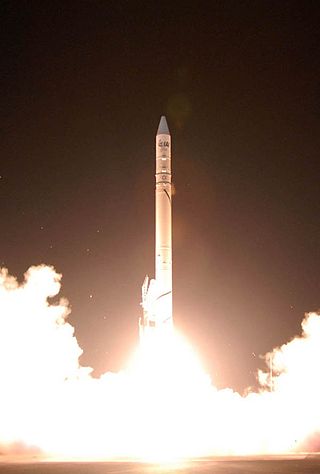
Shavit 2 is a small lift launch vehicle produced by Israel from 1982 onwards, to launch satellites into low Earth orbit. It was first launched on 19 September 1988, making Israel the eighth nation to have an orbital launch capability after the USSR, United States, France, Japan, People's Republic of China, United Kingdom, and India.

Proton ('proton') was a Soviet series of four cosmic ray and elementary particle detecting satellites. Orbited 1965–68, three on test flights of the UR-500 ICBM and one on a Proton-K rocket, all four satellites completed their missions successfully, the last reentering the Earth's atmosphere in 1969.
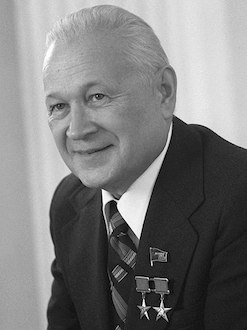
Vladimir Nikolayevich Chelomey or Chelomei was a Soviet engineer and designer in the missile program of the former Soviet Union. He invented the first Soviet pulse jet engine and was responsible for developing the world's first anti-ship cruise missiles and the ICBM program of the Soviet Union such as the UR-100, UR-200, UR-500 and UR-700.

The Kosmos rockets were a series of Soviet and subsequently Russian rockets, derived from the R-12 and R-14 missiles, the best known of which is the Kosmos-3M, which has made over 440 launches. The Kosmos family contained a number of rockets, both carrier rockets and sounding rockets, for orbital and sub-orbital spaceflight respectively. The first variant, the Kosmos-2I, first flew on 27 October 1961. Over 700 Kosmos rockets have been launched overall.

The UR-100 was an intercontinental ballistic missile (ICBM) developed and deployed by the Soviet Union from 1966 to 1996. UR (УР) in its designation stood for Universal Rocket. It was known during the Cold War by the NATO reporting name SS-11 Sego and internally by the GRAU index 8K84. The Strela and Rokot carrier rockets were based on it.
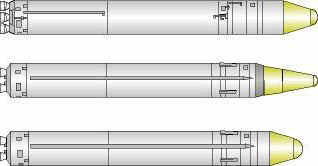
The UR-100N, also known as RS-18A, is an intercontinental ballistic missile in service with Soviet and Russian Strategic Missile Troops. The missile was given the NATO reporting name SS-19 Stiletto and carries the industry designation 15A30.

The Khrunichev State Research and Production Space Center is a Moscow-based manufacturer of spacecraft and space-launch systems, including the Proton and Rokot rockets, and the Russian modules of Mir and the International Space Station.

The year 1954 saw the conception of Project Orbiter, the first practicable satellite launching project, utilizing the Redstone, a newly developed Short Range Ballistic Missile.
The R-7 family of rockets is a series of rockets, derived from the Soviet R-7 Semyorka, the world's first intercontinental ballistic missile (ICBM). More R-7 rockets have been launched than any other family of large rockets.
Strela is a Russian orbital carrier rocket, derived from the Soviet/Russian UR-100NU missile. It conducted its maiden test launch on 5 December 2003, carried its first functional payload on 27 June 2013, and a second one on 19 December 2014.
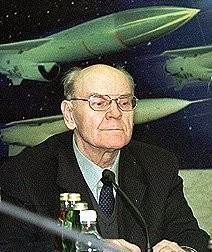
GerbertAleksandrovich Yefremov is a Soviet and Russian scientist, design engineer and Professor of Technical Sciences.
The RS-26 Rubezh SS-X-31 or SS-X-29B, is a Russian solid-fueled intercontinental ballistic missile, equipped with a thermonuclear MIRV or MaRV payload. The missile is also intended to be capable of carrying the Avangard hypersonic glide vehicle. The RS-26 is based on RS-24 Yars, and constitutes a shorter version of the RS-24 with one fewer stages. The development process of the RS-26 has been largely comparable to that of the RSD-10 Pioneer, a shortened derivative of the RT-21 Temp 2S. Deployment of the RS-26 is speculated to have a similar strategic impact as the RSD-10.

A super heavy-lift launch vehicle is a rocket that can lift to low Earth orbit a "super heavy payload", which is defined as more than 50 metric tons (110,000 lb) by the United States and as more than 100 metric tons (220,000 lb) by Russia. It is the most capable launch vehicle classification by mass to orbit, exceeding that of the heavy-lift launch vehicle classification.

The Avangard is a Russian hypersonic glide vehicle (HGV) that can be carried as an MIRV payload by the UR-100UTTKh, R-36M2 and RS-28 Sarmat heavy ICBMs. It can deliver both nuclear and conventional payloads. The Avangard is reportedly capable of travelling at re-entry speeds.


















